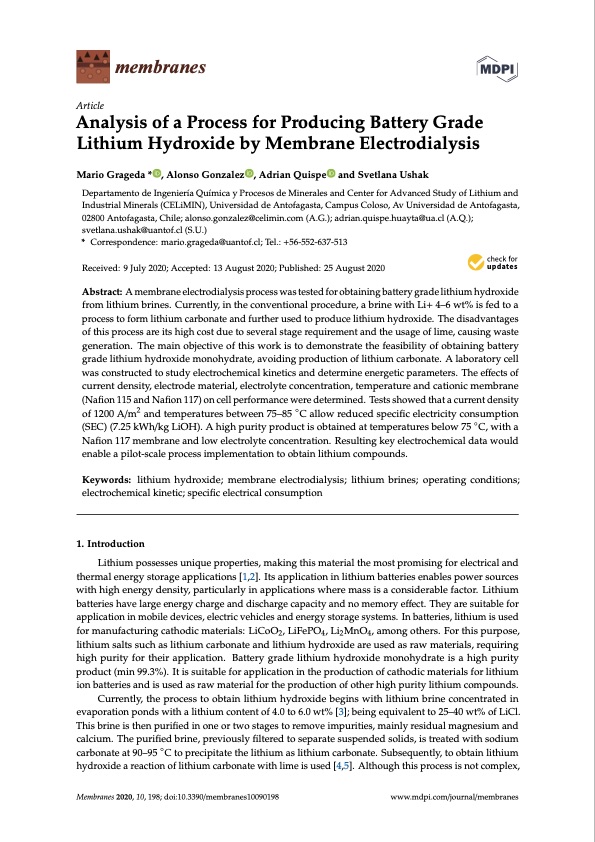
PDF Publication Title:
Text from PDF Page: 001
membranes Article Analysis of a Process for Producing Battery Grade Lithium Hydroxide by Membrane Electrodialysis Mario Grageda * , Alonso Gonzalez , Adrian Quispe and Svetlana Ushak Departamento de Ingeniería Química y Procesos de Minerales and Center for Advanced Study of Lithium and Industrial Minerals (CELiMIN), Universidad de Antofagasta, Campus Coloso, Av Universidad de Antofagasta, 02800 Antofagasta, Chile; alonso.gonzalez@celimin.com (A.G.); adrian.quispe.huayta@ua.cl (A.Q.); svetlana.ushak@uantof.cl (S.U.) * Correspondence: mario.grageda@uantof.cl; Tel.: +56-552-637-513 Received: 9 July 2020; Accepted: 13 August 2020; Published: 25 August 2020 Abstract: A membrane electrodialysis process was tested for obtaining battery grade lithium hydroxide from lithium brines. Currently, in the conventional procedure, a brine with Li+ 4–6 wt% is fed to a process to form lithium carbonate and further used to produce lithium hydroxide. The disadvantages of this process are its high cost due to several stage requirement and the usage of lime, causing waste generation. The main objective of this work is to demonstrate the feasibility of obtaining battery grade lithium hydroxide monohydrate, avoiding production of lithium carbonate. A laboratory cell was constructed to study electrochemical kinetics and determine energetic parameters. The effects of current density, electrode material, electrolyte concentration, temperature and cationic membrane (Nafion 115 and Nafion 117) on cell performance were determined. Tests showed that a current density of 1200 A/m2 and temperatures between 75–85 ◦C allow reduced specific electricity consumption (SEC) (7.25 kWh/kg LiOH). A high purity product is obtained at temperatures below 75 ◦C, with a Nafion 117 membrane and low electrolyte concentration. Resulting key electrochemical data would enable a pilot-scale process implementation to obtain lithium compounds. Keywords: lithium hydroxide; membrane electrodialysis; lithium brines; operating conditions; electrochemical kinetic; specific electrical consumption 1. Introduction Lithium possesses unique properties, making this material the most promising for electrical and thermal energy storage applications [1,2]. Its application in lithium batteries enables power sources with high energy density, particularly in applications where mass is a considerable factor. Lithium batteries have large energy charge and discharge capacity and no memory effect. They are suitable for application in mobile devices, electric vehicles and energy storage systems. In batteries, lithium is used for manufacturing cathodic materials: LiCoO2, LiFePO4, Li2MnO4, among others. For this purpose, lithium salts such as lithium carbonate and lithium hydroxide are used as raw materials, requiring high purity for their application. Battery grade lithium hydroxide monohydrate is a high purity product (min 99.3%). It is suitable for application in the production of cathodic materials for lithium ion batteries and is used as raw material for the production of other high purity lithium compounds. Currently, the process to obtain lithium hydroxide begins with lithium brine concentrated in evaporation ponds with a lithium content of 4.0 to 6.0 wt% [3]; being equivalent to 25–40 wt% of LiCl. This brine is then purified in one or two stages to remove impurities, mainly residual magnesium and calcium. The purified brine, previously filtered to separate suspended solids, is treated with sodium carbonate at 90–95 ◦C to precipitate the lithium as lithium carbonate. Subsequently, to obtain lithium hydroxide a reaction of lithium carbonate with lime is used [4,5]. Although this process is not complex, Membranes 2020, 10, 198; doi:10.3390/membranes10090198 www.mdpi.com/journal/membranesPDF Image | Battery Grade Li Hydroxide by Membrane Electrodialysis

PDF Search Title:
Battery Grade Li Hydroxide by Membrane ElectrodialysisOriginal File Name Searched:
membranes-10-00198.pdfDIY PDF Search: Google It | Yahoo | Bing
Product and Development Focus for Infinity Turbine
ORC Waste Heat Turbine and ORC System Build Plans: All turbine plans are $10,000 each. This allows you to build a system and then consider licensing for production after you have completed and tested a unit.Redox Flow Battery Technology: With the advent of the new USA tax credits for producing and selling batteries ($35/kW) we are focussing on a simple flow battery using shipping containers as the modular electrolyte storage units with tax credits up to $140,000 per system. Our main focus is on the salt battery. This battery can be used for both thermal and electrical storage applications. We call it the Cogeneration Battery or Cogen Battery. One project is converting salt (brine) based water conditioners to simultaneously produce power. In addition, there are many opportunities to extract Lithium from brine (salt lakes, groundwater, and producer water).Salt water or brine are huge sources for lithium. Most of the worlds lithium is acquired from a brine source. It's even in seawater in a low concentration. Brine is also a byproduct of huge powerplants, which can now use that as an electrolyte and a huge flow battery (which allows storage at the source).We welcome any business and equipment inquiries, as well as licensing our turbines for manufacturing.| CONTACT TEL: 608-238-6001 Email: greg@infinityturbine.com | RSS | AMP |